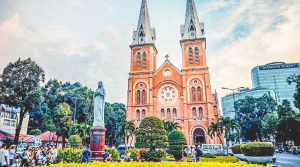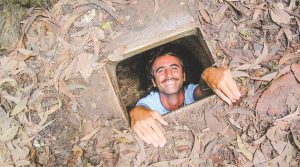Hang Son Doong, located deep within Phong Nha-Ke Bang National Park, is the largest cave in the world and an extraordinary natural wonder that has captivated adventurers from across the globe. Known for its vast chambers, unique ecosystems, and surreal landscapes, the cave offers a once-in-a-lifetime experience for those who dare to explore it. The 4-day expedition through Hang Son Doong takes travelers on an unforgettable journey into the heart of Vietnam’s most remarkable subterranean world. With only 1,000 visitors allowed each year, this exclusive adventure promises to leave you in awe.
- An Introduction
- Inside Hang Son Doong
- Highlights of Hang Son Doong
- 4 Day caving expedition
- How to get there
- Best time to visit
- Alternative caves & adventures
- Booking a Phong Nha Caving Expedition
An Introduction to The Worlds Largest Cave
Location
Hang Son Doong is located in Phong Nha-Ke Bang National Park, a remote and well-preserved area in central Vietnam. The park is about 500 kilometers south of Hanoi, bordered by Laos to the west and the South China Sea to the east. Nestled within the Truong Son mountain range, the park is part of a vast limestone massif, making it the perfect environment for the formation of hundreds of caves and grottoes. The park’s interconnected cave systems stretch over 200 kilometers in length, with Son Doong being the crown jewel of these subterranean wonders.
Origin of the name Son Doong
The cave was named by the team that first explored it, led by local guide Ho Khanh. The name “Son Doong” is a combination of two words: “Son,” meaning mountain, and “Doong,” referring to the valley where the ethnic minority Bru Van Kieu resides and where the cave was discovered. The Thuong River flows through the valley and into the cave, making the name a tribute to both the local geography and culture.
The Discovery
Hang Son Doong was first discovered in 1991 by Ho Khanh, a local man who stumbled upon the cave’s entrance while taking shelter from a storm in the jungle. At the time, he didn’t explore it, and the location was soon lost. It wasn’t until 2009, when Ho Khanh rediscovered the entrance, that he led a team of British cavers, including Howard Limbert, into the cave. Their exploration revealed the breathtaking scale of the cave, confirming that it was indeed the largest cave on Earth.
How big is Hang Son Doong?
Hang Son Doong is a giant in every sense. The cave is over 9 kilometers long, with sections reaching heights of more than 200 meters and widths of 175 meters. Some chambers are so large that they could house entire city blocks, and several 40-story skyscrapers could fit comfortably inside. Its vast size adds up to a volume of 38.5 million cubic meters, and new discoveries within the cave continue to add to its already staggering dimensions. The cave is so immense that its own weather systems, complete with clouds and mist, have been observed inside.
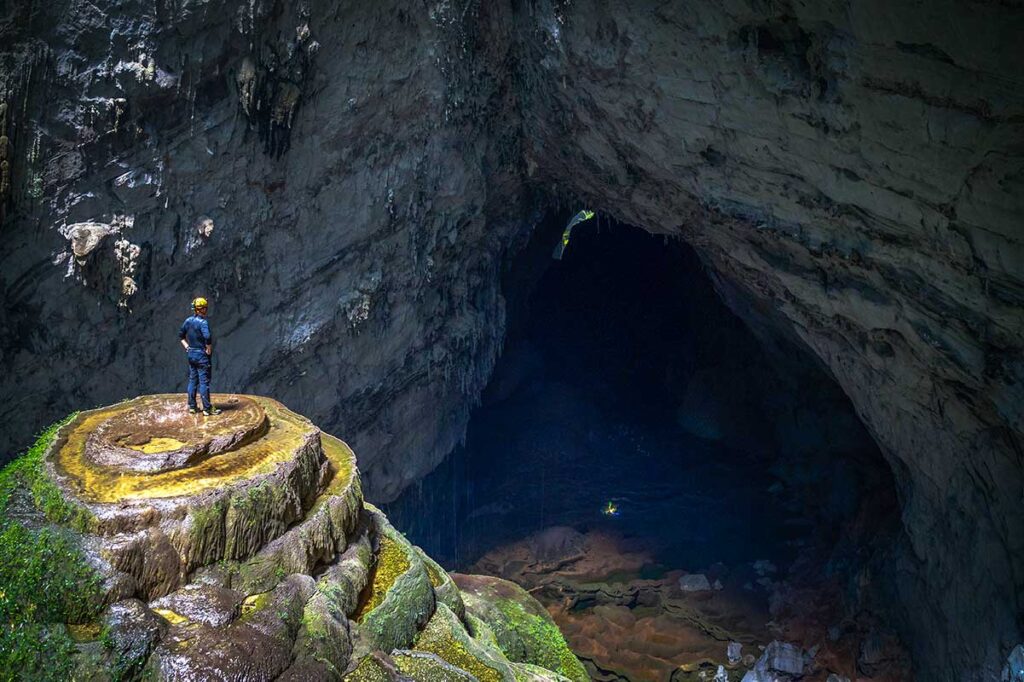
What is inside Hang Son Doong?
What makes Hang Son Doong truly extraordinary is the hidden world that exists within its vast chambers. It’s not just the sheer size that captivates visitors, but the unique features and ecosystems that have developed inside over millions of years.

Unique Features
- Microclimates: Due to its massive size, Hang Son Doong has distinct microclimates within different parts of the cave. These unique climates influence everything from humidity to temperature, creating varied ecosystems. This range of conditions allows different plant and animal species to thrive in specific areas, making the cave’s ecosystem as diverse as its terrain.
- Stalagmites and Stalactites: The cave is home to some of the largest stalagmites and stalactites in the world. Formations here reach heights of up to 80 meters, towering over the cave floor like ancient stone pillars. These formations are the result of millions of years of mineral-rich water dripping through the limestone, slowly creating these spectacular natural sculptures.
- Ecosystem: Inside the cave, life thrives in unexpected ways. Lush vegetation grows in certain areas, supported by light filtering through the cave’s massive skylights. These natural openings allow rainwater and sunlight to penetrate, creating mini jungles deep within the cave. Along with the plant life, Son Doong is home to various insects, fish, and even birds, making it a living ecosystem in the heart of the earth.
Hidden Rivers and Lakes
One of the cave’s most fascinating features is its underground river, which snakes through sections of the cave, forming subterranean lakes and waterfalls. This underground water system is fed by the Thuong River, which flows through the cave and continues to shape the landscape. Exploring these hidden waterways is one of the highlights of the expedition, offering a rare glimpse into the geological forces that created this subterranean wonder.

Highlights of Hang Son Doong
Hang Son Doong offers an array of breathtaking natural wonders and unique geological features that set it apart as the world’s largest cave. Here are some of the most awe-inspiring highlights that visitors encounter during the 4-day expedition:
The Hope and Vision Passage
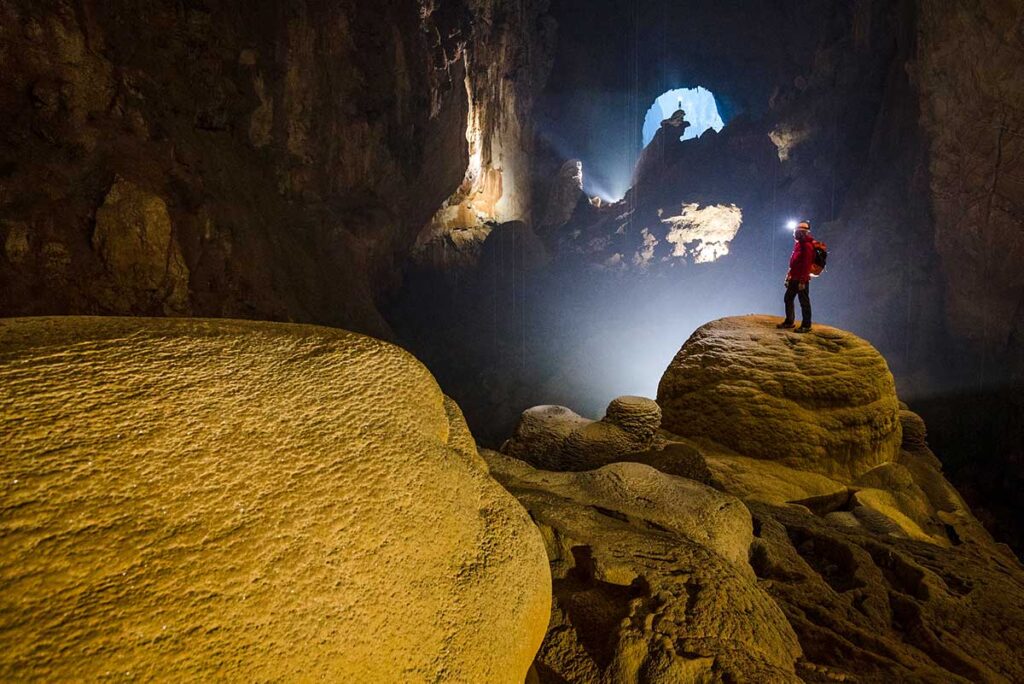
The Hope and Vision Passage is one of the most iconic parts of Hang Son Doong, stretching for approximately 1.5 kilometers. The passage is so large that a Boeing 747 could glide through its arches. The towering stalagmites and stalactites within this passage add to its grandeur. Two notable formations stand out here: the “Hand of Dog,” a 60-meter-high stalagmite, and the world’s tallest stalagmite, reaching an astonishing height of 80 meters. This passage exemplifies the cave’s size and the natural beauty hidden within its walls.
The Underground River
Son Doong is home to an underground river that winds through parts of the cave. This river is fed by the Thuong River and flows through En Cave and Khe Ry Cave, creating stunning subterranean waterways. The river flows over cascades and waterfalls and eventually disappears deep inside the cave. Crossing this underground river is a thrilling part of the expedition, adding to the sense of adventure and mystery.
The Sinkholes
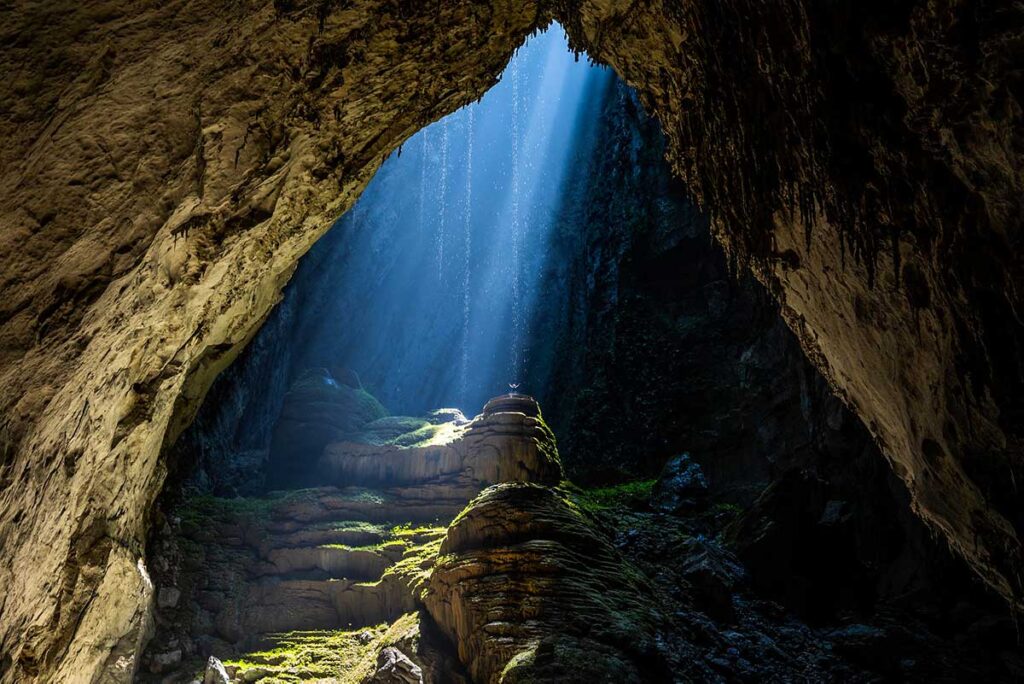
Hang Son Doong is known for its two massive sinkholes, Doline 1 and Doline 2, which were formed by the collapse of the cave ceiling.
- Doline 1 (“Watch Out for Dinosaurs”): This skylight opens to the outside world, creating a 450-meter-high chamber that lets sunlight filter into the cave. The light beams illuminate the passageways in a magical display, especially between January and March, when the sun’s angle creates an incredible spectacle.
- Doline 2 (“Garden of Edam”): Located about a kilometer from Doline 1, this sinkhole is home to a lush, primeval forest that thrives 200 meters inside the cave. Thanks to the sunlight and moisture penetrating the porous limestone walls, the Garden of Edam is a unique and vibrant ecosystem flourishing in the heart of the cave.
The Great Wall of Vietnam
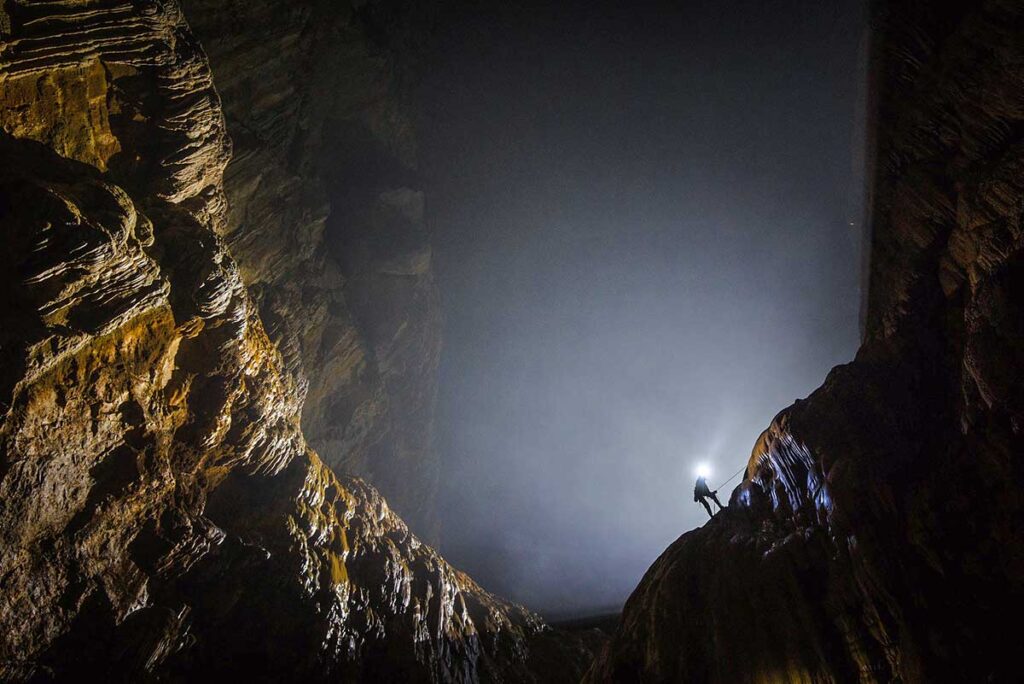
One of the most challenging and awe-inspiring features of Hang Son Doong is the Great Wall of Vietnam, a massive calcite flowstone that rises nearly 100 meters high. When first discovered, it took the British caving team two days to conquer this natural barrier using specialized climbing techniques. Today, an 18-meter-high stainless steel ladder and safety ropes help visitors scale the wall during the expedition, providing both a thrilling and rewarding experience.
Cave Pearls
Among the many wonders inside Hang Son Doong are the rare and stunning cave pearls. These spherical formations are created by the slow accumulation of calcium salts from dripping water over centuries. The pearls vary in size, some as small as pebbles, while others are larger. They shine with a glossy finish, resembling precious gems scattered across the cave floor. Although touching them is prohibited to preserve their delicate structure, they are an unforgettable sight for visitors.
Hang Son Doong 4 Day caving expedition
Exploring Hang Son Doong is an exclusive and exhilarating adventure that spans 4 days within the world’s largest cave. The experience is led by Oxalis Adventure, the only tour operator licensed to guide visitors through this remarkable natural wonder. This multi-day expedition not only takes you deep into the heart of Son Doong but also includes jungle trekking, river crossings, and overnight camping within the cave. Here’s what you can expect from the journey:
Oxalis Adventure
Oxalis Adventure is based in Son Trach town, approximately 50 kilometers from Dong Hoi City. The tour provides transportation from Dong Hoi to Phong Nha, with a 40-minute ride to the starting point. Due to the exclusivity and environmental sensitivity of the cave, tours are limited to just 1,000 visitors per year, ensuring minimal impact on the ecosystem. The cost of the tour is over $3,000 USD per person, and while the price may seem steep, it covers all essential services, including transportation, guides, safety teams, food, accommodation, and caving equipment.
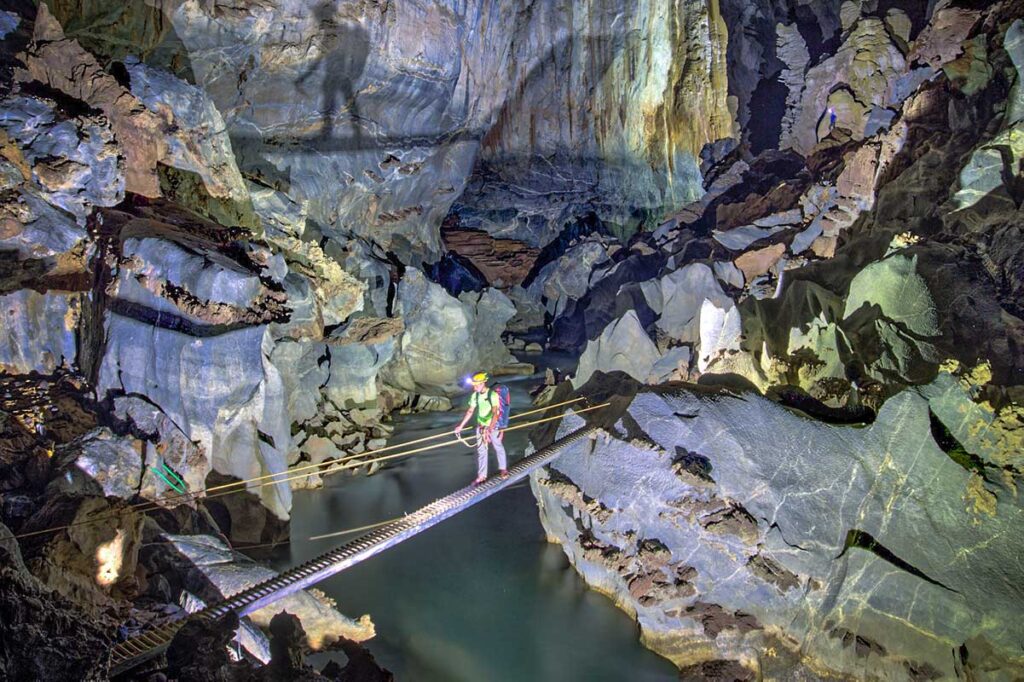
The Expedition
The entire experience lasts 6 days, with 4 full days dedicated to exploring the jungle and Son Doong Cave itself. Each group is limited to a maximum of 10 participants, ensuring a personalized and safe experience. The tour is led by experienced guides, many of whom were part of the original British caving team that explored Son Doong in 2009. Along with the guides, the group includes safety assistants, cooks, porters, and a park ranger to help with all aspects of the journey.
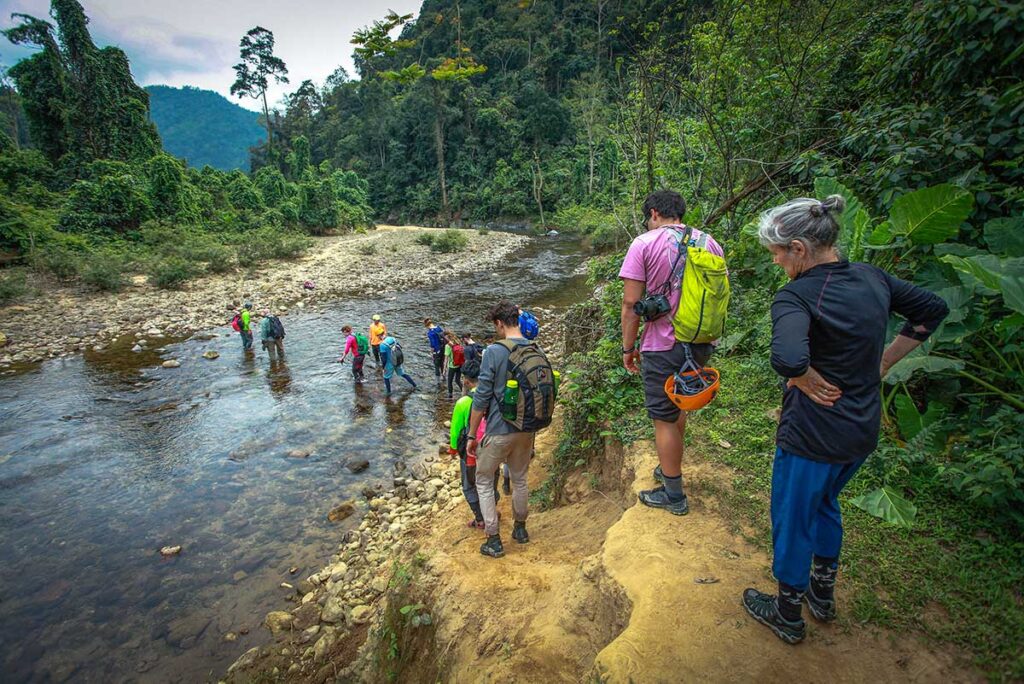
During the 4-day trek, visitors will cover a distance of 25 kilometers, including 8 kilometers inside the cave. The expedition is physically demanding, with rough terrain, river crossings, and steep climbs. However, you don’t need to be an expert caver—some trekking experience and a moderate level of fitness are enough to complete the journey.
Camping in the Cave

One of the highlights of the Hang Son Doong expedition is the chance to camp inside the cave itself. In 2017, Hang Son Doong was named the most impressive campsite in the world by the British Daily Mail. Spending the night inside the vast chambers, surrounded by the natural beauty of the cave, is an unforgettable experience. The mystical atmosphere, with the sound of flowing water and the towering cave walls, creates an otherworldly camping experience like no other.
Swimming in the Underground Lakes and Rivers
Throughout the expedition, visitors will have the chance to cool off by swimming in the underground rivers and lakes within the cave. The water is clean, cool, and refreshing, offering a welcome break from the challenging trek. While the waters are generally safe, it’s important to follow the instructions of the guides, as some areas may have strong currents.
Physical Requirements
The expedition to Hang Son Doong is not for the faint of heart. A good level of physical fitness is essential, as you’ll need to walk long distances over rugged terrain and camp in basic conditions. The journey involves river crossings, rock scrambling, and hiking through dense jungle, making it a challenging but rewarding adventure.
Disconnect from the Outside World
During the expedition, you will have no access to phone signals or Wi-Fi. This means you’re completely disconnected from the outside world, giving you the rare opportunity to immerse yourself fully in the experience. With no distractions, you’ll be able to focus entirely on the breathtaking beauty of Son Doong and the pristine nature surrounding you.
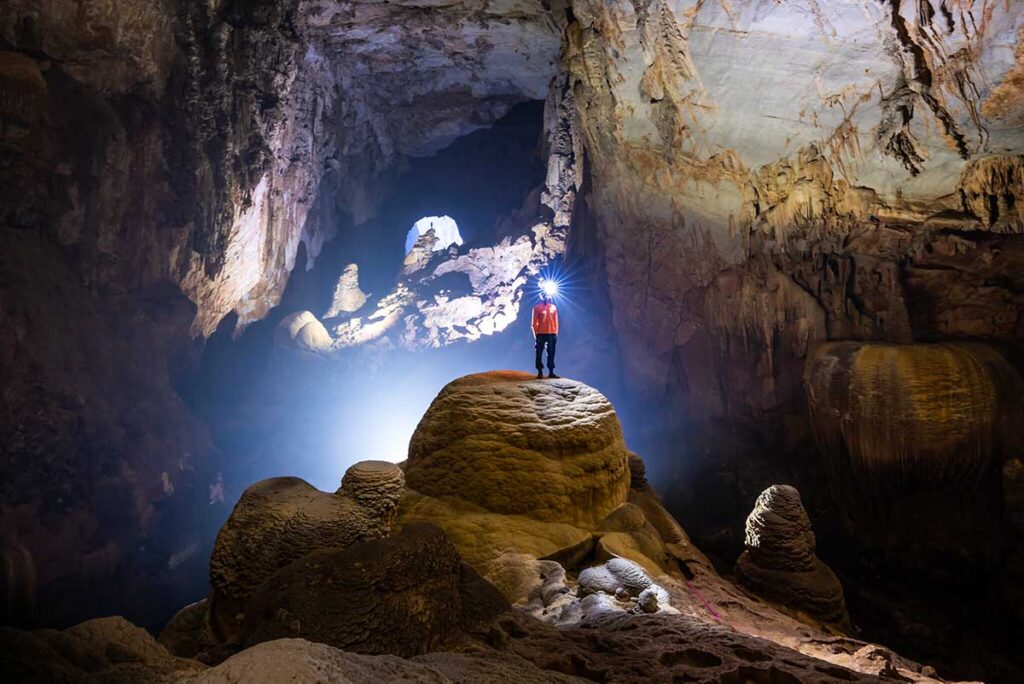
How to get there
Traveling to Hang Son Doong requires several steps, as it is located in a remote area deep within Phong Nha-Ke Bang National Park. To reach the cave, you’ll first need to travel to Dong Hoi, the nearest city, and then make your way to Phong Nha, where the expedition begins.
Step 1: Travel to Dong Hoi
Depending on where you’re coming from in Vietnam, there are several ways to reach Dong Hoi:
- Flying
Dong Hoi has a small domestic airport with direct flights from Hanoi (1 hour) and Ho Chi Minh City (1.5 hours). Flights are limited, with only 1 to 3 flights per day, so it’s essential to book your tickets in advance. - Train
Dong Hoi lies along the Reunification Express railway, which connects major cities in Vietnam. Trains from Hanoi, Ninh Binh, and Hue are available, making it a convenient option for those preferring to travel by rail. The train journey from Hanoi takes approximately 10-12 hours, while trips from Hue or Da Nang take 4-6 hours. - Bus
Long-distance buses run regularly to Dong Hoi from cities like Hanoi, Da Nang, and Hue. While the bus ride may be longer, it’s an affordable and reliable option for travelers.
Step 2: From Dong Hoi to Phong Nha
Once in Dong Hoi, you’ll need to cover the 50-kilometer distance to Phong Nha, where the cave expedition begins. There are two main ways to make this journey:
- Bus
A bus ride from Dong Hoi to Phong Nha takes about an hour and is the cheapest way to travel. Buses depart from the Dong Hoi bus station and cost approximately $2-3 USD. - Private Car
Hiring a private car or taxi is a faster and more convenient option, allowing you to schedule your pick-up and drop-off times. The car ride takes around 45 minutes and offers a more comfortable journey through the scenic countryside.
Step 3: Phong Nha to Hang Son Doong
From Phong Nha, the only way to reach Hang Son Doong is by joining the official expedition led by Oxalis Adventure. The trek begins in Phong Nha and takes you deep into the jungle before reaching the cave.
Best time to visit?
Hang Son Doong is only accessible during the dry season, which runs from January to the end of August each year. During the wet season, the cave becomes impassable due to rising water levels, making it unsafe for exploration. Here’s what you can expect during each part of the dry season:
January to March
The early months of the dry season can be quite cool, with temperatures dropping in the evenings. However, the cooler weather also makes trekking through the jungle and exploring the cave more comfortable. During this time, you might also witness the stunning phenomenon of sunlight beams piercing through the skylight in Hang En Cave, illuminating the campsite in a magical way.
April to May
These months are considered some of the best times to visit Hang Son Doong. The weather is warm and pleasant, and the landscapes begin to come alive with blooming flowers and lush greenery. It’s also during this time that mist and clouds sometimes form inside the cave, creating an ethereal atmosphere.
June to August
These are the warmest months of the year, but despite the heat, the trek remains comfortable thanks to the dense jungle canopy and the cooler temperatures inside the cave, which hover between 22 and 25 degrees Celsius. The warm weather also makes swimming in the underground lakes a refreshing experience.
Alternative caves & adventures
Hang Son Doong may be the crown jewel of Phong Nha’s caves, but it’s not accessible for everyone due to the cost, time commitment, and limited availability. Fortunately, Phong Nha-Ke Bang National Park is home to many other incredible caves and adventure experiences, catering to different budgets, fitness levels, and time frames. Here are a few options that still offer the thrill of exploring Vietnam’s underground world.
Hang En Cave
Hang En is the third-largest cave in the world and is part of the Hang Son Doong expedition. For those looking for a shorter but still breathtaking adventure, the Hang En Cave trek is an excellent alternative. The tour includes camping inside the cave next to a picturesque lake, where you can enjoy a unique overnight experience surrounded by the cave’s towering walls and stunning formations.
Tu Lan Cave System
The Tu Lan cave system offers a more challenging experience for adventure seekers. This multi-cave expedition involves a combination of trekking, abseiling, swimming through underground rivers, and scrambling over rocky terrain. The adventure takes you through a series of stunning caves, each with its unique formations, underground waterfalls, and beautiful jungle scenery.
Hang Pygmy
Hang Pygmy, the fourth-largest cave in the world, provides a less extreme but equally awe-inspiring experience. While the adventure still involves trekking and caving, it is more accessible than some of the other caves in the area, making it a great option for a broader range of visitors. The massive chambers and impressive formations in Hang Pygmy will leave you in awe of Vietnam’s underground beauty.
For those seeking other exciting caves to explore, check out our guide to the best caves in Phong Nha, where you’ll find a wide range of options catering to different levels of adventure.
Booking a Phong Nha Caving Expedition
At Local Vietnam, we specialize in organizing customized tours and caving expeditions throughout Phong Nha. Whether you’re looking for a jungle trekking experience, an adventurous multi-day cave tour, or an easier cave walk, we can help you find the perfect match based on your interests, fitness level, and time frame. We work closely with licensed tour operators and experienced guides to ensure that every aspect of your trip is safe, exciting, and tailored to your needs.
Beyond the caves, we can help design a complete itinerary for your Vietnam trip, including transportation, accommodations, and other activities to make your journey unforgettable. If you’re interested in exploring the caves of Phong Nha or want to create a custom Vietnam adventure, contact us today to plan your perfect trip.
